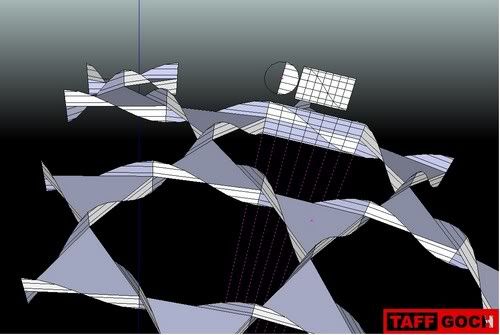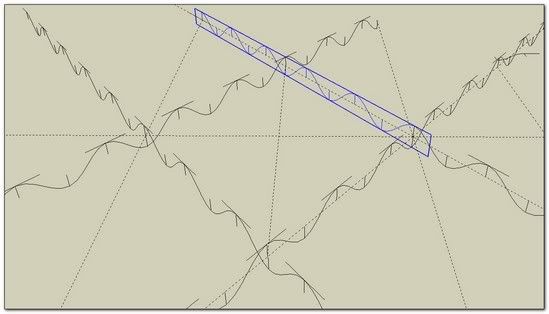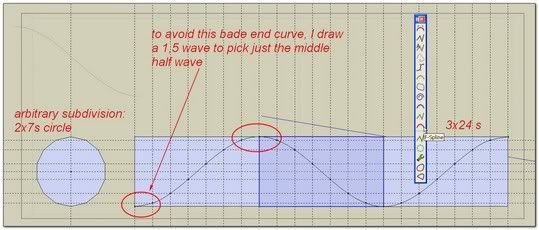An exercise: DRAWING A PARISIAN FENCE
-
Hi Guys,
I wanted to suggest you an exercise some month ago and had forgotten it under the pile..
A challenge from Taff Goch Various rendering choices? -- Challenge!
Rico91 proposition

had given me some element of solution and so I reload my proposition:this was: " HOW TO DRAW A PARISIAN FENCE ? "



In my mind the problem was "how to draw a sinusoid following the path of one element (component) and matching the good crossover at the various meeting points?"

The solution you (Taff Goch) had applied to your geodesic weave sphere opens to me some idea to achieve this..
-one element of answer is that each component goes with a neighbor mirrored one.
clic to enlarge

But it remains a difficult exercise I guess

 simon
simon
PS: I'm completely found of your warehouse geodesic collection -
Seems this 2 components sufficient?

As it's 3D volumes, you can flip vertically the second components for have all possibilities! (front / back)
click image

Don't know how are the bottom and finished sides?
-
Hi Pilou

Decompose into these two basic components seems a good idea.
This way we can work with some simplicity on the problems of overlapping sinusoids. We can may be at the end use yours to make the component I was primarily thinking of in order to avoid any pb of seams@unknownuser said:
Don't know how are the bottom and finished sides?
Remain to draw these curved and angled sinusoids..
@+ s
-
Simon,
Consider how the manufacturer produced the fence. Q: With what did they start?
A: A length of "wire," with a constant, repeated sine wave. This should be maintained in a 3D model. Keep all of the sinusoidal segments the same length.
Truly, the sine segments along the top of the fence will be curved, but they should be maintained at the same length. I can demonstrate this evening, when I have some modeling time.
-Taff
-
@taffgoch said:
Simon,
Consider how the manufacturer produced the fence. Q: With what did they start?
A: A length of "wire," with a constant, repeated sine wave. This should be maintained in a 3D model. Keep all of the sinusoidal segments the same length.
Truly, the sine segments along the top of the fence will be curved, but they should be maintained at the same length. I can demonstrate this evening, when I have some modeling time.
-Taff
So true..i just quit because of that
 .
. -
When i thought i have figured it out

 ,disaster(see how the wires intersect in the left down corner and ..of course ,they are not woven)
,disaster(see how the wires intersect in the left down corner and ..of course ,they are not woven)

More trials to go
 .
. -
@unknownuser said:
Remain to draw these curved and angled sinusoids..
When you have flat model
Curved can be made by the Fredo Scale, no?
-
hmm..just..wow..clearly u know some maths .
-
Wahoo! "bravo" Taff
 _ and I feel the result beautiful
_ and I feel the result beautiful 
Now I know it can be done, I want to find the way: with your indications but without open your skp yet.
and I'm actually in front of the picture expecting something stand up from my perplexity


I shall come back
*simon
-
@simon le bon said:
...and I'm actually in front of the picture expecting something stand up from my perplexity
Simon,
As I wrote earlier, I had a couple of false starts, until I studied the picture more closely...

Each unit/increment is half of a sine wave (crest-to-trough, or trough-to-crest.) I finally recognized that each diamond was 6-units wide, having 5-unit side lengths. Only then would model components fit together properly.-Taff
-
@simon le bon said:

I know it's not the subject of this thread, but that image would make a great map with an opacity mask on it

-
True, I was also thinking about it. You can easily make it tilable horizontally, too - the only problem is that vertically it should be a bit higher so that you could apply it on more various (although of course, still limited) height.
-
-
@ely862me said:
Mr Simon,watch it, because they are now weaving.
 Ely, I don't understand what that means..
Ely, I don't understand what that means..Well: there is a problem with my previous test.
If I use 6 by 6 half waves as shown, the wiring doesn't braid!!!let me see...
*s -
Mr Simon,watch it, because they are now weaving.
Edited:Mr Simon,watch it, because they are NOT weaving(braiding). (sorry
 not so usual words for me
not so usual words for me  )
) -
I meant it s not braiding.
U must follow the indication from Taff : 5 by 6(diagonal)


-
Taff, you are right!
And Ely too (you are quicker than me )
)
The diamond need to be done with an odd number of semi waves.If I take the same wave and use 5 semi waves:

that works perfectly.
if I analyze better the fence -( I take a pen an a shit of paper and draw the wave blindely, just looking to the picture, i discover you are right: 5x5 semi waves!)
and draw the wave blindely, just looking to the picture, i discover you are right: 5x5 semi waves!)A good point
going to next step..
simon -
@unknownuser said:
shit of paper

Otherwise an excellent study to compliment Taff's Geodesic Challenge.
Look forward to the 'Loop' mathematics

Rich
-
The beginning was ''almost'' easy..the next step..i dare to say, it ll be the last
 ,but good luck anyway!
,but good luck anyway! -
Advertisement

















